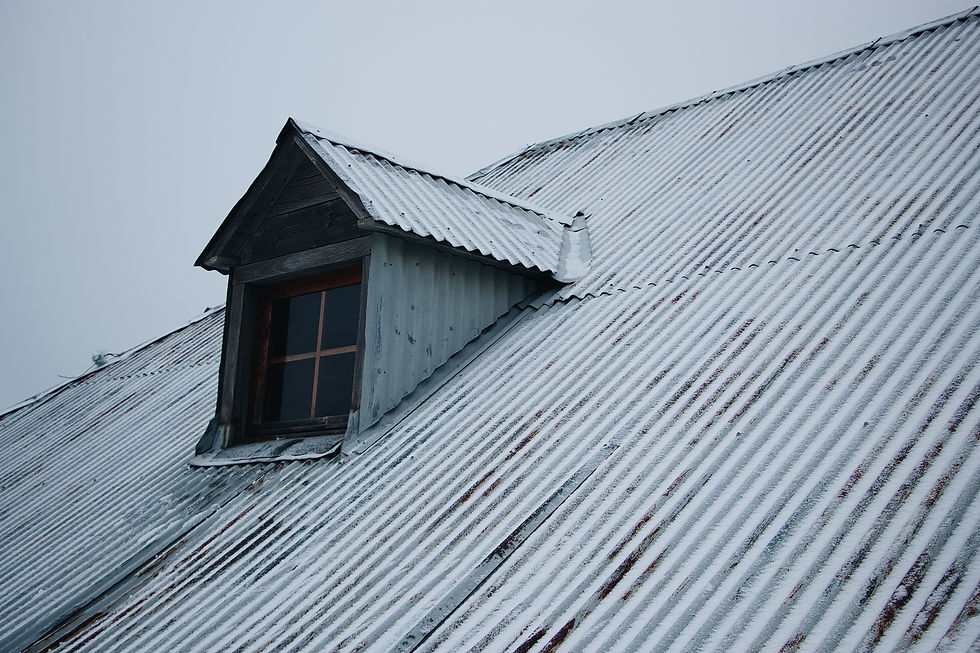☀️ Evaporative vs Reflective Roofing: Which Cooling Strategy Delivers on Climate?
- Melanie Galpin

- Jul 18
- 3 min read

With record-shattering heatwaves sweeping across Europe this summer, the design of rooftops is no longer just an architectural detail; it’s a frontline climate issue.
In July 2025 alone:
Temperatures in Spain reached 46 °C
Over 100 cities across France, Italy, Germany, and the UK were placed under red alert
Energy grids faced peak demand from cooling systems
The World Meteorological Organization confirmed that Europe is warming at twice the global average
As cities search for passive cooling strategies to adapt to this accelerating heat, two options lead the conversation: reflective “cool” roofs and evaporative roof systems. But how do they compare; and which solution is best suited for the climate challenges ahead?
Let’s dive in.
❄️ What Is a Cool Roof?
Cool roofs are engineered to reflect sunlight and absorb less solar heat. Typically coated in light-colored, high-albedo materials, they can reduce rooftop surface temperatures by up to 30 °C during peak sun hours.
According to the U.S. Department of Energy, buildings with cool roofs can reduce indoor cooling needs by 10–40% depending on location.
Reflective coatings have been shown to reduce urban air temperatures by 1–2 °C when adopted at scale in dense cities.
They’re relatively lightweight, inexpensive, and easy to apply.
But while cool roofs reduce radiant heat, they don’t address the urban water cycle. They don’t retain or reuse rainfall, they don’t evaporate water, and they don’t influence humidity. This makes them incomplete in areas facing both rising heat and declining rainfall.
💧 What Is an Evaporative Roof?
Evaporative roofs, like WaterRoofs, are designed to retain rainwater and gradually release it into the atmosphere through evaporation. This process mimics the natural cooling effect of tree canopies or forest soil; what scientists refer to as latent heat cooling.
Here’s how WaterRoofs works:
Recycled PET tiles with integrated micro-channels capture and hold rainwater
Water is slowly released as vapor, cooling the surrounding air
Each square meter of tile can return up to 750 L of water per year to the atmosphere
The system provides ongoing cooling; even hours after the sun sets
Evaporative roofs don’t just reflect heat; they remove it from the system entirely, all while helping to restore local humidity and atmospheric moisture.
🆚 Comparing the Two Approaches
Here’s a head-to-head comparison of cool roofs and evaporative roofs across key climate performance criteria:
Feature | Cool Roofs | Evaporative Roofs (e.g. WaterRoofs) |
Surface temperature reduction | High (reflective albedo) | Moderate (via water retention) |
Ambient air cooling | 1–2 °C max at street level | Up to 3–5 °C via latent heat exchange |
Cooling during night | Limited (no radiation to reflect) | Sustained cooling through evaporation |
Rainwater interaction | None (shed immediately) | Captures & releases rain into air |
Impact on urban humidity | Neutral | Increases atmospheric moisture |
Effectiveness in drought | Reduced performance (no water function) | High if rainwater is harvested or stored |
Material sustainability | Coatings vary (some petrochemical-based) | 100% recycled PET, modular, reusable |
Maintenance | Re-coating required over time | Low-maintenance tiles |
🌡️ What the Science Says
Recent research confirms that evaporative surfaces outperform reflective ones in extreme heat conditions:
A 2024 study published in Energy and Buildings found that evaporative roofs can reduce surrounding air temperatures by 3.2 °C on average; compared to 1.3 °C for reflective roofs under similar conditions.
Evaporative systems are also more effective in dry, low-humidity regions; precisely where conventional air conditioning is least efficient and urban overheating is most dangerous.
In short: reflective roofs reduce sun absorption, but evaporative roofs actively cool the air; and they work harder as temperatures rise.
🌍 Why This Matters for Urban Climate Resilience
As heatwaves grow longer and more severe, urban adaptation must do more than block the sun; it must rebalance the atmosphere.
Evaporative technologies provide four key climate functions that cool roofs alone cannot:
Reduce surrounding air temperature (not just surface temperature)
Slow stormwater runoff and flooding
Restore atmospheric humidity to help stabilize local microclimates
Reduce air pollution and dust by reintroducing moisture
WaterRoofs is the only modular, evaporative roofing system made from 100% recycled PET; providing both climate function and circular design.
🏗️ The Future of Rooftops
In a world of extreme climate, the best solutions aren’t either/or; they’re layered.
Cool roofs reflect. Evaporative roofs restore. WaterRoofs does both; while using waste plastic to build water-positive architecture.
Whether retrofitted on existing buildings or integrated into new urban planning, evaporative roofing is emerging as a critical component of tomorrow’s resilient cities.
Let’s stop draining our cities dry.Let’s start designing rooftops that breathe.
🟩 Discover more at: www.waterroofs.com



Comments